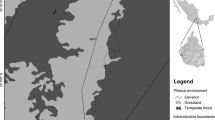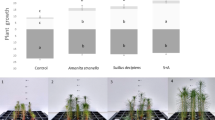Abstract
Pinus tabulaeformis (Chinese pine) is a widely planted conifer species in northern China and is used for soil and water conservation on the Loess Plateau. Due to its strong reliance on ectomycorrhizae and low survival rate from damping-off during seedling cultivation and in nurseries, we explored the early influence of three ectomycorrhizal fungi (Handkea utriformis, Suillus lactifluus, and Suillus tomentosus) on the growth, root morphological characters, root vitality, and survival of P. tabulaeformis seedlings from subsequent damping-off in a pot experiment. In addition, the in vitro suppression of three ectomycorrhizal fungi on the damping-off pathogen (Fusarium solani) was evaluated and observed using a scanning electron microscope. We found that all three ectomycorrhizal fungi could colonize more than 40% of the roots of P. tabulaeformis, promote plant shoot and root growth, increase the proportion of large-diameter roots, improve root vitality, and increase survival rates 3 months after inoculation. All three ectomycorrhizal fungi suppressed the growth of F. solani to a different extent in vitro. Ectomycorrhizal fungal hyphae proliferated and wrapped around the hyphae of F. solani when the hyphae encountered each other. The colonization rate of P. tabulaeformis roots was highly correlated with root vitality and root growth parameters, while the survival rate of P. tabulaeformis seedlings was highly correlated with the colonization rate of P. tabulaeformis roots, root vitality and growth. Our results suggest that early contact between P. tabulaeformis and ectomycorrhizal fungi could improve plant growth and resistance against damping-off.


Similar content being viewed by others
References
Akema T, Futai K (2005) Ectomycorrhizal development in a Pinus thunbergii stand in relation to location on a slope and effect on tree mortality from pine wilt disease. J For Res 10(2):93–99
Allen MF (1991) The ecology of mycorrhizae. Cambridge University Press, New York
Allen TW, Enebak SA, Carey WA (2004) Evaluation of fungicides for control of species of Fusarium on longleaf pine seed. Crop Prot 23(10):979–982
Almeida FBR, Cerqueira FM, Silva RN, Ulhoa CJ, Lima AL (2007) Mycoparasitism studies of Trichoderma harzianum strains against Rhizoctonia solani: evaluation of coiling and hydrolytic enzyme production. Biotechnol Lett 29:1189–1193
Aoki T, O’Donnell K, Homma Y, Lattanzi AR (2003) Sudden-death syndrome of soybean is caused by two morphologically and phylogenetically distinct species within the Fusarium solani species complex-F. virguliforme in North America and F. tucumaniae in South America. Mycologia 95(4):660–684
Aoki T, O’Donnell K, Geiser DM (2014) Systematics of key phytopathogenic Fusarium species: current status and future challenges. J Gen Plant Pathol 80(3):189–201
Bâ AM, Duponnois R, Moyersoen B, Diédhiou AG (2012) Ectomycorrhizal symbiosis of tropical African trees. Mycorrhiza 22(1):1–29
Bai SL, Li GL, Liu Y, Dumroese RK, Lv RH (2009) Ostryopsis davidiana seedlings inoculated with ectomycorrhizal fungi facilitate formation of mycorrhizae on Pinus tabulaeformis seedlings. Mycorrhiza 19(6):425–434
Brundrett MC (2009) Mycorrhizal associations and other means of nutrition of vascular plants: understanding the global diversity of host plants by resolving conflicting information and developing reliable means of diagnosis. Plant Soil 320(1–2):37–77
Cairney JWG (2011) Ectomycorrhizal fungi: the symbiotic route to the root for phosphorus in forest soils. Plant Soil 344(1–2):51–71
Chen K, Abbott RJ, Milne RI, Tian XM, Liu J (2008) Phylogeography of Pinus tabulaeformis Carr. (Pinaceae), a dominant species of coniferous forest in northern China. Mol Ecol 17(19):4276–4288
Chu H, Wang C, Wang H, Chen H, Tang M (2016) Pine wilt disease alters soil properties and root-associated fungal communities in Pinus tabulaeformis forest. Plant Soil 404(1):237–249
Clemensson-Lindell A, Persson H (1995) Fing-root vitability in a Norway spruce stand subjected to various nutrient supplies. Plant Soil 168–169:167–172
Corcobado T, Moreno G, Azul AM, Solla A (2015) Seasonal variations of ectomycorrhizal communities in declining Quercus ilex forests: interactions with topography, tree health status and Phytophthora cinnamomi infections. Forestry 88(2):257–266
Corrêa A, Strasser RJ, Martins-Loução MA (2006) Are mycorrhiza always beneficial? Plant Soil 279(1–2):65–73
Diáz G, Carrillo C, Honrubia M (2009) Production of Pinus halepensis seedlisngs inocualted with the edible fungus Lactarius deliciosus under nursery conditions. New For 38:512–527
Dick MA, Dobbie K (2002) Species of Fusarium on Pinus radiata in New Zealand. N Z Plant Prot 55:58–62
Gao JF (2000) Techniques of plant physiology. Word Publishing Corporation, Xi’an
Giovannetti M, Mosse B (1982) An evaluation of techniques for measuring vesicular–arbuscular mycorrhizal infection in roots. New Phytol 84(3):489–500
Giron D, Frango E, Glevarec G, Pieterse CMJ, Dicke M (2013) Cytokinins as key regulators in plant-microbe-insect interaction: connecting plant growth and defence. Funct Ecol 27:599–609
Gola EM (2014) Dichotomous branching: the plant form and integrity upon the apical meristem bifurcation. Front Plant Sci 5:263
Hoagland DR, Arnon DI (1950) The water-culture method for growing plants without soil. Circular. 356 California Agricultural Experiment Station 347, 2nd edn
Hwang SF, Chakravarty P, Chang KF (1995) The effect of two ectomycorrhizal fungi, Paxillus involutus and Suillus tomentosus, and of Bacillus subtilis on Fusarium damping-off in jack pine seedlings. Phytoprotection 76(2):57–66
Larsen PE, Sreedasyam A, Trivedi G, Podila GK, Cseke LJ, Collart FR (2011) Using next generation transcriptome sequencing to predict an ectomycorrhizal metabolome. BMC Syst Biol 5:70
Lazreg F, Belabid L, Sanchez J, Gallego E, Bayaa B (2014) Pathogenicity of Fusarium spp. associated with diseases of Aleppo-pine seedlings in Algerian forest nurseries. J For Sci 60(3):115–120
Machón P, Pajares JA, Diez JJ, Alves-Santos FM (2009) Influence of the ectomycorrhizal fungus Laccaria laccata on pre-emergence, post-emergence and late damping-off by Fusarium oxysporum and F. verticillioides on Stone pine seedlings. Symbiosis 49(2):101–109
Martín-Pinto P, Pajares J, Díez J (2006) In vitro effects of four ectomycorrhizal fungi, Boletus edulis, Rhizopogon roseolus, Laccaria laccata and Lactarius deliciosus on Fusarium damping off in Pinus nigra seedlings. New For 32(3):323–334
Mosca E, Montecchio L, Sella L, Garbaye J (2007) Short-term effect of remobing tree competition on the ectomycorrhizal status of a declining pedunculate oak forest (Quercus robur L.). For Ecol Manag 244:129–140
Ouahmane L, Revel JC, Hafidi M, Thioulouse J, Prin Y, Galiana A, Dreyfus B, Duponnois R (2009) Responses of Pinus halepensis growth, soil microbial catabolic functions and phosphate-solubilizing bacteria after rock phosphate amendment and ectomycorrhizal inoculation. Plant Soil 320(1–2):169–179
Pena R, Simon J, Rennenberg H, Polle A (2013) Ectomycorrhiza affect architecture and nitrogen partitioning of beech (Fagus sylvatica L.) seedlings under shade and drought. Environ Exp Bot 87:207–217
Pereira E, Coelho V, Tavares RM, Lino-Neto T, Baptista P (2012) Effect of competitive interactions between ectomycorrhizal and saprotrophic fungi on Castanea sativa performance. Mycorrhiza 22(1):41–49
Phillips JM, Hayman DS (1970) Improved procedures for clearing roots and staining parasitic and vesicular-arbuscular mycorrhizal fungi for rapid assessment of infection. Trans Br Mycol Soc 55(1):158–161
Pregitzer KS, DeForest JL, Burton AJ, Allen MF, Ruess RW, Hendrick RL (2002) Fine root architecture of nine North American trees. Ecol Monogr 72(2):293–309
Raudaskoski M, Kothe E (2015) Novel findings on the role of signal exchange in arbuscular and ectomycorrhizal symbioses. Mycorrhiza 25(4):243–252
Richter AK, Frossard E, Brunner I (2007) Polyphenols in the woody roots of Norway spruce and European beech reduce TTC. Tree Physiol 27(1):155–160
Saravesi K, Markkola A, Rautio P, Roitto M, Juha Tuomi J (2008) Defoliation causes parallel temporal responses in a host tree and its fungal symbionts. Oecologia 156:117–123
Smith SE, Read DJ (2008) Mycorrhizal symbiosis, 3rd edn. Academic Press, New York
Tang M, Zhang RQ, Chen H, Zhang HH, Tian ZQ (2008) Induced hydrolytic enzymes of ectomycorrhizal fungi against pathogen Rhizoctonia solani. Biotechnol Lett 30:1777–1782
Taniguchi T, Kataoka R, Futai K (2008) Plant growth and nutrition in pine (Pinus thunbergii) seedlings and dehydrogenase and phosphatase activity of ectomycorrhizal root tips inoculated with seven individual ectomycorrhizal fungal species at high and low nitrogen conditions. Soil Biol Biochem 40(5):1235–1243
Tarkka MT, Herrmann S, Wubet T et al (2013) OakContigDF159. 1, a reference library for studying differential gene expression in Quercus robur during controlled biotic interactions: use for quantitative transcriptomic profiling of oak roots in ectomycorrhizal symbiosis. New Phytol 199(2):529–540
Tedersoo L, May TW, Smith ME (2010) Ectomycorrhizal lifestyle in fungi: global diversity, distribution, and evolution of phylogenetic lineages. Mycorrhiza 20(4):217–263
Trocha LK, Kałucka I, Stasińska M, Nowak W, Dabert M, Leski T, Rudawska M, Oleksyn J (2012) Ectomycorrhizal fungal communities of native and non-native Pinus and Quercus species in a common garden of 35-year-old trees. Mycorrhiza 22:121–134
Trocha LK, Weiser E, Robakowski P (2016) Interactive effects of juvenile defoliation, light conditions, and interspecific competition on growth and ectomycorrhizal colonization of Fagus sylvatica and Pinus sylvestris seedlings. Mycorrhiza 26(1):47–56
Vayssières A, Pěnčík A, Felten J, Kohler A, Ljung K, Martin F, Legué V (2015) Development of the poplar-Laccaria bicolor ectomycorrhiza modifies root auxin metabolism, signaling, and response. Plant Physiol 169(1):890–902
Wang Q, Guo LD (2010) Ectomycorrhizal community composition of Pinus tabulaeformis assessed by ITS-RFLP and ITS sequences. Botany 88:590–595
Wang J, Huang Y, Jiang XY (2011) Influence of ectomycorrhizal fungi on absorption and balance of essential elements of Pinus tabulaeformis seedlings in saline soil. Pedosphere 21(3):400–406
Yin D, Deng X, Chet I, Song R (2014a) Physiological responses of Pinus sylvestris var. mongolica seedlings to the interaction between Suillus luteus and Trichoderma virens. Curr Microbiol 69(3):334–342
Yin D, Deng X, Chet I, Song R (2014b) Physiological responses of Pinus sylvestris var. mongolica seedlings to the interaction between Suillus luteus and Trichoderma virens. Curr Microbiol 69(3):334–342
Zhang RQ, Tang M, Chen H, Tian ZQ (2011a) Effects of ectomycorrhizal fungi on damping-off and induction of pathogenesis-related proteins in Pinus tabulaeformis seedlings inoculated with Amanita vaginata. For Pathol 41:262–269
Zhang RQ, Tang M, Zhang H, Du X (2011b) A preliminary investigation on ectomycorrhizal in Huoditang forest region of Qinling mountain. J Qingdao Agri Univ (Nat Sci) 28(3):168–173
Zhang H, Liu Z, Chen H, Tang M (2016a) Symbiosis of arbuscular mycorrhizal fungi and Robinia pseudoacacia L. improves root tensile strength and soil aggregate stability. PLoS ONE 11(4):e0153378
Zhang H, Yu H, Tang M (2016b) Isolation, identification and cultivation of ectomycorrhizal fungus Handkea utriformis in the rhizosphere of Pinus tabulaeformis. Acta Bot Boreal-Occident Sin 36(2):0419–0425
Zhou Z, Shangguan Z (2007) Vertical distribution of fine roots in relation to soil factors in Pinus tabulaeformis Carr. forest of the Loess Plateau of China. Plant Soil 291(1):119–129
Acknowledgements
This study was supported by the National Natural Science Foundation of China (41671268 and 31270639, http://www.nsfc.gov.cn/), the Shaanxi Science and Technology Innovation Project Plan (2016KTCL02-07), the Excellent Young Teachers Training Program of Northwest A&F University (Z111021605), and the Fundamental Research Fund of Northwest A&F University (2452015169).
Author information
Authors and Affiliations
Corresponding author
Rights and permissions
About this article
Cite this article
Zhang, H., Yu, H. & Tang, M. Prior contact of Pinus tabulaeformis with ectomycorrhizal fungi increases plant growth and survival from damping-off. New Forests 48, 855–866 (2017). https://doi.org/10.1007/s11056-017-9601-9
Received:
Accepted:
Published:
Issue Date:
DOI: https://doi.org/10.1007/s11056-017-9601-9




